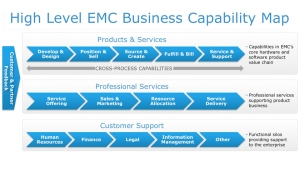Planning our EMC IT strategy to meet the company’s future business capability requirements is a lot like planning for the future growth of a city. For a city to thrive and prosper, leaders must holistically coordinate infrastructure projects and resources across municipal departments to meet the needs and demands of its residents within city policies–hopefully with the least amount of bureaucracy. Road improvements, for example, need to link to traffic and development patterns and not conflict with sewer or water line installation.
As EMC’s business has become more complex, EMC IT has been striving to work closely with business units in a similarly holistic approach to map out what capabilities they need and how IT can support them. We are in the process of forging such a strategic plan for the current year, based on an increasing level of collaboration with the business units we serve.
We first began this roadmapping process—which is part of demand management—three years ago to address the increasingly complex range of capabilities required by our evolving business units. Prior to that, we relied on an annual budget process that tended to focus on a siloed, rather than a holistic, approach to shaping our strategy.
The roadmap approach essentially leverages business architecture techniques to set our IT strategy in collaboration with the business—i.e. what are our baseline business capabilities, what is the status of such capabilities (green, red, yellow), and what does IT need to do to further these capabilities and, thus, the company’s goals? It is analogous to a city planning process sizing up the basic services a city needs to provide, how well it is providing them and what infrastructure or public service projects need to be budgeted to keep pace with future demands.
A major focus of IT’s roadmapping effort is to identify and link business capability needs to our large-scale IT platforms, such as our SAP-based ERP (Enterprise Resource Planning) or our CRM (Customer Relationship Management) systems. This allows us to determine what business needs can be met by leveraging existing functionality in the platforms and others that require IT to build a solution outside of the core platforms. The goal is to extend our platforms out as much as possible, streamlining and standardizing processes wherever possible to gain efficiencies rather than customizing solutions.
Consider, for example, the vast array of steps that are part of a new EMC product launch. It is a process that cuts across all product lines and touches numerous IT and business functions, including manufacturing, licensing, product catalog and product support. The main issue for IT is how that product gets into the system. We have to ensure that EMC has the business capabilities to accommodate the new product. Can we manufacture it? How will the SKU be created; what is the licensing model? Can we configure it and price it? Can we ship it? How will we track the customer service process?
Clearly, it makes sense to standardize such product launch capabilities rather than treating each one as its own entity. So, in collaboration with the business, we have analyzed the set of processes that determine how a newly launched product gets incorporated into the backbone of the company and have worked further to streamline them.
The demand management collaboration process has enabled us to forge a common vocabulary with the business to foster an ongoing planning dialogue. We stay connected via regular communication. For example, we have BCIO’s (Business Chief Information Officers who work within IT and are liaisons to the business) meeting regularly with the business to share information and help hone our roadmaps.
On the technology side of the house, we share our roadmaps with CTO’s and product managers from the business units during our quarterly IT Technology Advisory Board meetings. At every session, we also focus on one particular topic for which we have the business share their roadmap.
The resulting collaboration has helped shape our ongoing evolution from a siloed IT operation to one focused on enterprise-wide projects as well as business-unit specific projects. It has also helped us align and develop our roadmaps from a business perspective in terms of where the business wants to go. We work together to answer the question of what big ticket items we need to consider for the next year and whether we have the resources and technology to do them.
We also use the business roadmaps to strategize on how our IT capabilities, such as IT-as-a-Service (including such popular services as Business-Analytics-as-a-Service), Cloud or IT Proven, fit in to our business capability needs.
The collaborative (Business+IT) roadmapping process is one that is evolving. Each year we have gotten better at communicating with the business and refining our IT strategy to meet their needs and leverage efficiencies our new cloud delivery model. In doing so, we are able to make sure our services remain relevant in a changing IT world and that our business units have the technology-enabled business capabilities they need to remain agile and keep our company moving forward.